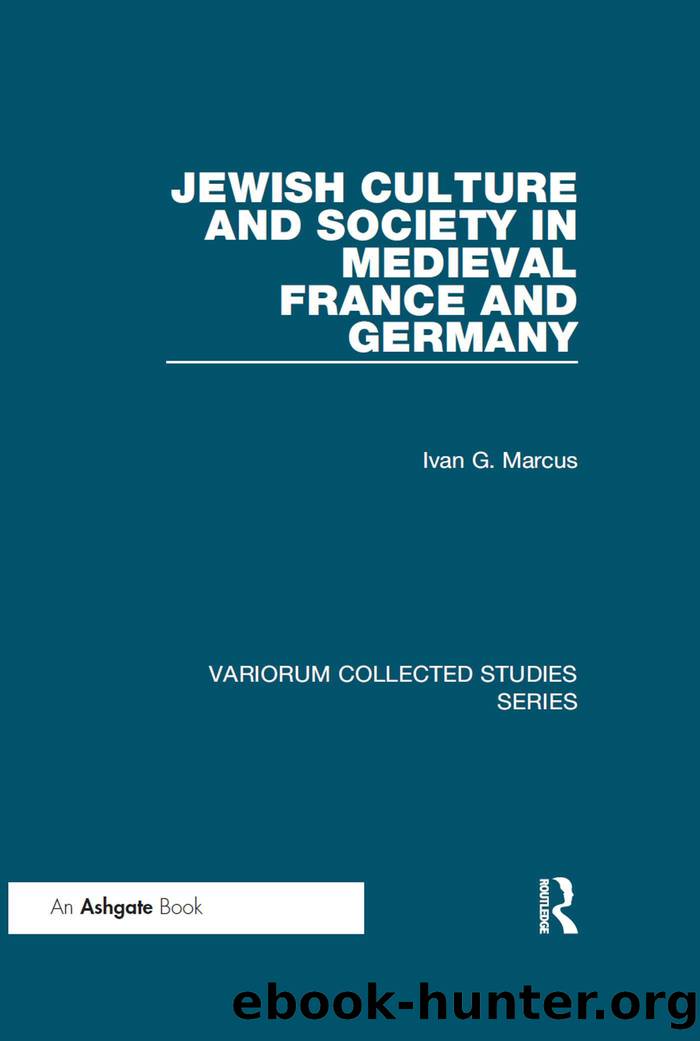Jewish Culture and Society in Medieval France and Germany by Ivan G. Marcus;

Author:Ivan G. Marcus;
Language: eng
Format: epub
Publisher: Taylor & Francis (Unlimited)
Published: 2014-08-15T00:00:00+00:00
Many have written about this narrative that looks like history, especially with the intent of determining the degree to which this story is âtrueâ in the sense of being âfactual.â33 As we saw, a similar effort was made regarding the Story of the Four Captives,34 and the same can be said about the Charlemagne account about Narbonne35 or about Aḥimaazâs rhymed narrative from southern Italy.36 This approach is understandable, even though it is doubtful that any real progress can be made here because the sources are not documentary in character. Even if one date or another happens to be found in such a narrative, as is the case with one of the parallels to the Mainz account,37 it is highly doubtful that it is reliable. Apart from errors due to manuscript transmission, we should consider the purposely fabricated symbolic dates found in Ibn Daudâs account, as Gerson Cohen demonstrated.38
A different approach would not ask, Are there facts here as opposed to legends? but: Why were these and not other legends created and preserved? What is their historical significance in the collective memory of this community? In this way we confront two distinct, if related, aspects of the meaning of a narrative that looks like history. On the one hand, we are asking, Does the content of the narrative as constructed and remembered, have historical meaning? And on the other hand, we want to know what can be learned from the narrative and from other evidence about the fact that this narrative appeared only at a specific point in time, long after the time the narrative itself claims to represent. âContentâ and timing are related but distinct historical features of collective memory.
This approach, which I call the âanthropological historicalâ one, takes the data in the narrative seriously even though it is not considered factual. It views the details as part of the collective memory of a community or of a subgroup in it. It pays attention to the context of the narrativeâits selection of protagonists and plotâand it also focuses on why the narrative appeared when it did.
The Mainz Carolingian story suggests true historical recollections embedded in it despite the fact that there was no such event.39 Among other things, it reminds us that the gradual emergence of northern European Jewish societies was made secure for individual Jewish merchants, in the ninth century, and for German Jewish communities, in the eleventh, by the charters that were first issued by Carolingian monarchs or their imitators. In this sense the story preserves a true âfact,â for the Carolingians gave legitimacy, security, and support to the early Ashkenazic merchant communities. Immigration from Italy and France, not a single âevent,â âfoundedâ the earliest communities; but the story that remembers such an event incorporates the true memory that Charlemagne (d. 814) and his son Louis the Pious (d. 840) played an important part in the early history of Ashkenazic community building.40
In another sense, too, the narrative of a transfer from Italy to Germany resonates with a true historical process that took place in the Frankish Empire.
Download
This site does not store any files on its server. We only index and link to content provided by other sites. Please contact the content providers to delete copyright contents if any and email us, we'll remove relevant links or contents immediately.
The Vikings: Conquering England, France, and Ireland by Wernick Robert(79222)
Ali Pasha, Lion of Ioannina by Eugenia Russell & Eugenia Russell(39939)
The Vikings: Discoverers of a New World by Wernick Robert(36830)
The Conquerors (The Winning of America Series Book 3) by Eckert Allan W(36715)
Cecilia; Or, Memoirs of an Heiress — Volume 1 by Fanny Burney(32092)
Cecilia; Or, Memoirs of an Heiress — Volume 3 by Fanny Burney(31481)
Cecilia; Or, Memoirs of an Heiress — Volume 2 by Fanny Burney(31435)
Empire of the Sikhs by Patwant Singh(22779)
Hans Sturm: A Soldier's Odyssey on the Eastern Front by Gordon Williamson(18341)
The Secret History by Donna Tartt(18267)
Cat's cradle by Kurt Vonnegut(14804)
Sapiens: A Brief History of Humankind by Yuval Noah Harari(14006)
Pimp by Iceberg Slim(13828)
Talking to Strangers by Malcolm Gladwell(12916)
Norse Mythology by Gaiman Neil(12879)
Leonardo da Vinci by Walter Isaacson(12833)
Underground: A Human History of the Worlds Beneath Our Feet by Will Hunt(11857)
4 3 2 1: A Novel by Paul Auster(11842)
The Radium Girls by Kate Moore(11651)
